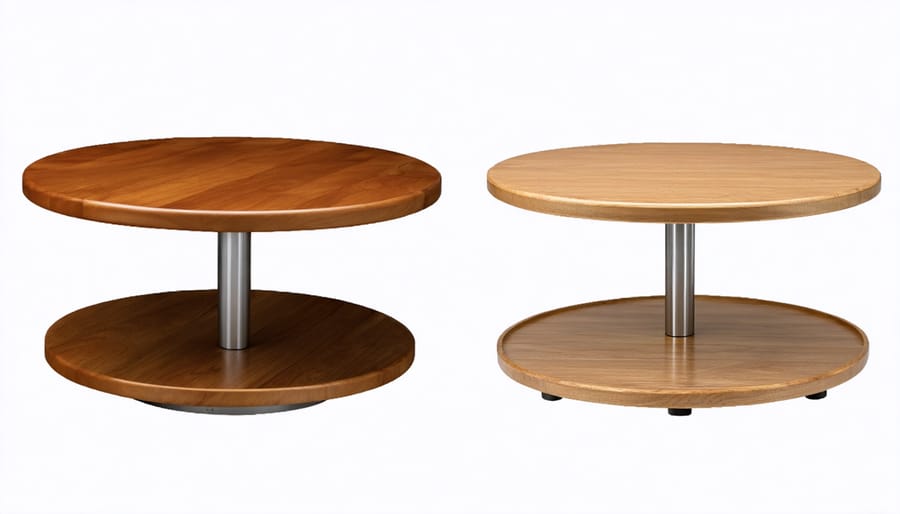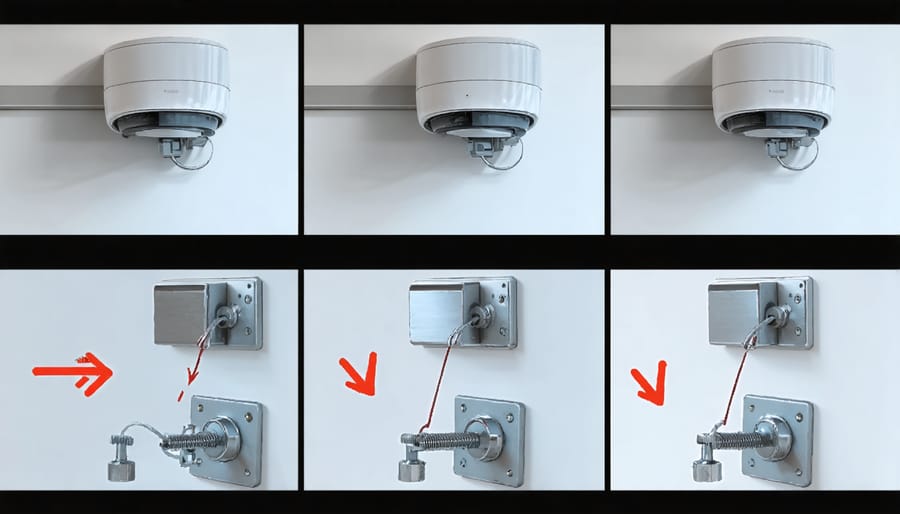Transform your kitchen organization with the right corner cabinet solution – the choice between a Lazy Susan and Super Susan can significantly impact your storage efficiency and daily cooking routine. While both systems feature rotating shelves for corner cabinet access, they serve different needs and spaces. A Lazy Susan offers a classic circular design with independently spinning trays, perfect for smaller cabinets and budget-conscious renovations. In contrast, the Super Susan delivers enhanced stability and storage capacity through its pie-shaped shelves that move as a single unit, utilizing up to 25% more cabinet space. Understanding these key differences helps you maximize your kitchen’s potential, whether you’re planning a complete renovation or simply upgrading your storage solutions. Let’s explore how each system’s unique features can match your specific kitchen needs and organization goals.

What Makes a Lazy Susan Different from a Super Susan?
Traditional Lazy Susan Features
Traditional Lazy Susans have been a kitchen cabinet staple for decades, featuring a simple yet effective circular rotating design. These platforms typically consist of one or two shelves mounted on a central bearing mechanism, allowing smooth rotation for easy access to items stored in corner cabinets. When shopping for best Lazy Susan options, you’ll find they’re commonly made from durable materials like plastic, wood, or metal.
The classic design includes a round or kidney-shaped shelf that rotates 360 degrees, with a weight capacity usually ranging from 20 to 50 pounds. Most traditional models feature raised edges to prevent items from falling off during rotation, and they often come in white or almond colors to match standard cabinet interiors.
One distinctive characteristic is their fixed height configuration – what you see is what you get. The shelves are permanently mounted at specific heights, which can sometimes limit storage flexibility. While this straightforward design has served households well, it does mean that some corner cabinet space above and below the shelves may go unused.
Installation is typically straightforward, making these units a popular choice for DIY enthusiasts and homeowners looking for a basic corner cabinet solution.
Super Susan Innovation
The Super Susan represents a significant leap forward in cabinet organization technology, offering several innovative features that set it apart from its predecessor. Unlike traditional lazy susans, Super Susans typically come with adjustable shelves that can accommodate items of varying heights. They also feature a smooth ball-bearing mechanism that ensures quieter, more reliable rotation even when heavily loaded.
One of the most notable improvements is the independent shelf rotation system, allowing you to turn each level separately. This means you can access items on different shelves without disturbing the organization of others. Many Super Susan models also include a soft-close feature that prevents sudden stops and potential item spillage.
The corners of Super Susan shelves are often designed with raised edges or guardrails, keeping items secure during rotation. Some modern versions even incorporate LED lighting systems that automatically illuminate when the cabinet door opens, making it easier to locate items in dark corner cabinets. The mounting hardware has also been upgraded, featuring stronger materials and more precise installation methods that ensure long-term stability and smoother operation.
Storage Capacity and Space Efficiency
Corner Space Utilization
When it comes to maximizing corner cabinet space, both Lazy Susans and Super Susans offer unique solutions, though they approach the challenge differently. Traditional different Lazy Susan styles typically utilize about 70-80% of the available corner space, with some dead space in the corners due to their circular design. The rotating shelves make items accessible, but the circular shape means you might lose some storage potential in the square cabinet corners.
Super Susans, on the other hand, make use of nearly 90% of the corner space thanks to their kidney-shaped or pie-cut design. The shelves swing out completely from the cabinet, allowing you to utilize the entire corner area more effectively. While both systems keep items from getting lost in the back of deep cabinets, Super Susans excel at maximizing every inch of available space.
The key difference lies in how each system approaches the corner: Lazy Susans rotate within the space, while Super Susans pivot out to bring contents forward. This means Super Susans can accommodate larger items and oddly shaped containers more easily, though they require more clearance space when in use. Consider your specific storage needs and cabinet dimensions when choosing between these options.

Weight Capacity and Stability
When it comes to storage capacity, Super Susans typically outperform their Lazy Susan counterparts. A well-built Super Susan can usually handle between 80 to 100 pounds of items, making them ideal for storing heavy pots, appliances, and bulk pantry items. This higher weight capacity comes from their more robust construction and better weight distribution across multiple shelves.
Lazy Susans, while still practical, generally support around 30 to 50 pounds. This makes them better suited for lighter items like spices, condiments, and small containers. Their single bearing mechanism, while reliable, isn’t designed for extremely heavy loads.
In terms of stability, Super Susans have a distinct advantage. Their center pole mounting system provides excellent support and prevents wobbling, even when fully loaded. The shelves move independently, which helps distribute weight more evenly and reduces stress on the mechanism.
Lazy Susans rely on a simpler rotating platform design. While this works well for everyday use, they can sometimes feel less stable, especially when reaching for items at the back. However, they’re less likely to have mechanical issues since they have fewer moving parts.
Pro tip: Always check the manufacturer’s specific weight ratings before loading either system, as capacities can vary between brands and models.
Installation and Maintenance Considerations

Installation Complexity
When it comes to installation, Lazy Susans generally offer a more straightforward DIY-friendly approach. They typically come with basic mounting hardware and require minimal tools – usually just a screwdriver and measuring tape. Most homeowners with basic handyman skills can install a Lazy Susan in about 30-45 minutes.
Super Susans, on the other hand, present a more complex installation process. Their mechanisms involve multiple moving parts, precise alignment requirements, and often need additional bracketing for stability. While ambitious DIYers can tackle the installation, many homeowners prefer professional help to ensure proper functionality and avoid potential issues with the sliding mechanism.
For both systems, accurate measurements are crucial. However, Super Susans require extra attention to detail due to their corner-maximizing design and multiple shelf configurations. If you’re considering DIY installation, factor in about 1-2 hours for a Super Susan setup, and be prepared with a complete tool set including a power drill, level, and various screwdrivers.
Professional installation costs typically range from $100-200 for a Lazy Susan and $150-300 for a Super Susan, including labor and any additional materials needed.
Long-term Maintenance
Both Lazy Susans and Super Susans require different approaches to long-term maintenance to ensure they continue functioning smoothly. Lazy Susans, with their simpler mechanism, generally need less maintenance but may require occasional cleaning of the bearing and light lubrication every few years. A quick wipe-down of the shelves and checking for loose screws twice a year is usually sufficient.
Super Susans, while more robust, have more moving parts that need attention. The sliding mechanism and hinges should be checked quarterly for smooth operation and lubricated as needed. The good news is that their sturdy construction typically means fewer repairs over time, though when issues do arise, they might be more complex to fix.
For both systems, keeping the rotating mechanism free from crumbs and debris is crucial. Using a vacuum with a narrow attachment can help reach tight spots. If you notice any squeaking or resistance in either system, a food-grade silicone lubricant can work wonders. Remember to check weight limits and distribute items evenly to prevent unnecessary strain on the mechanisms, ensuring years of reliable service.
Making the Right Choice for Your Kitchen
When choosing between a Lazy Susan and Super Susan for your kitchen, several key factors can help guide your decision to maximize kitchen storage space effectively. First, consider your cabinet size and shape. If you have standard corner cabinets (24-inch depth), a traditional Lazy Susan might be your best bet. However, for larger corner spaces or L-shaped cabinets, a Super Susan could offer better utilization of the available space.
Budget plays a crucial role in your decision-making process. Lazy Susans typically cost less and are easier to install, making them perfect for DIY enthusiasts or those working with limited funds. Super Susans, while pricier, offer enhanced functionality that could justify the investment for long-term use.
Think about your storage needs and daily kitchen habits. If you primarily store lightweight items like spices, packaged foods, or small containers, a Lazy Susan works wonderfully. For heavier items like pots, pans, or appliances, a Super Susan’s sturdy construction and higher weight capacity make it the smarter choice.
Installation complexity should also factor into your decision. If you’re planning a DIY installation, Lazy Susans are generally more straightforward to set up. Super Susans often require professional installation due to their more complex mechanisms and precise fitting requirements.
Consider your household’s accessibility needs. Lazy Susans work well for most users but might require more reaching and bending. Super Susans, with their pull-out design, bring items closer to you, making them ideal for users with limited mobility or in households where multiple people of different heights access the cabinet regularly.
The right choice ultimately depends on balancing these factors with your specific needs. For rental properties or temporary solutions, a Lazy Susan might be the most practical choice. For permanent homes or kitchen renovations where longevity and functionality are priorities, investing in a Super Susan could provide better long-term value.
When choosing between a Lazy Susan and Super Susan, the key differences come down to storage capacity, accessibility, and space utilization. Super Susans generally offer more efficient storage with their pull-out design and better use of corner cabinet space, making them ideal for larger kitchens or households with extensive storage needs. However, Lazy Susans remain a reliable, budget-friendly option that’s easier to maintain and perfect for smaller spaces or simpler storage requirements.
For most modern kitchens, we recommend the Super Susan if budget allows, as it provides superior organization and accessibility. That said, if you’re working with a tighter budget or prefer a simpler mechanism, a traditional Lazy Susan will still serve you well. Consider your specific storage needs, cabinet size, and daily usage patterns when making your final decision. Either choice will significantly improve your kitchen’s organization and functionality compared to a standard corner cabinet.
